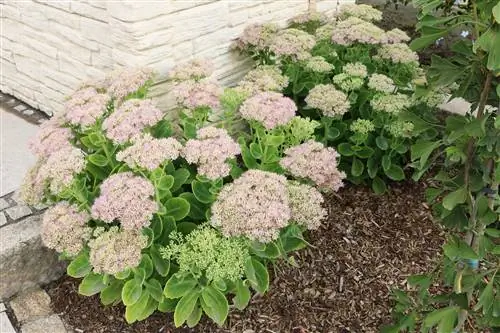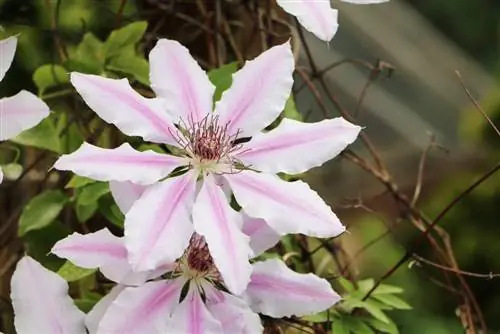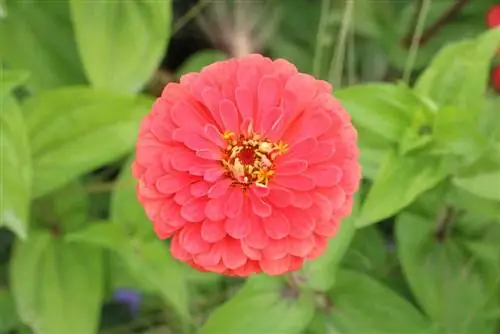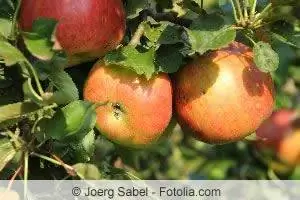- Author admin [email protected].
- Public 2023-12-17 03:39.
- Last modified 2025-06-01 06:48.
The sedum actually doesn't deserve the name because of its appearance. This plant is a very diverse genus. There are around 500 different species of sedum. The plant is mainly found in northern latitudes. The sedum feels at home here and grows almost everywhere. The sedum is very easy to care for and undemanding. There are species that only grow to around 10 to 20 tall and are therefore well suited as ground cover. Other species grow up to 60 cm tall. The variety of flowers in the sedum is also very broad. Many color ranges are covered, from a delicate pink to a strong yellow. The flowers are arranged in a star shape, while the leaves are fleshy. This also made the plant resistant to a short dry period. The leaves store a lot of water so that the water requirements can be met by the leaves. The flowering time varies depending on the plant genus. As a rule, however, the stonecrop blooms from May to October.
Sowing and propagation
You can purchase sedum seeds at the garden center. Sowing is preferably carried out in spring and is sown over a wide area. As soon as the plants reach a height of five to ten cm, they are placed 20 cm apart from each other. This means the plants have enough space to grow sufficiently. The soil should be permeable so that no waterlogging can form. You can also buy the plant ready-made and plant it whole. When the sedum feels comfortable and has grown well, the plant can be propagated by dividing. To do this, remove the sedum from the soil and loosen the soil from the roots. The next step is to divide the plant by gently pulling it apart. The plant parts are now planted individually in the ground or in a pot.
Plants
The sedum is an incredibly robust plant. In 2011 it was voted Perennial of the Year. It has also been found that the sedum itself appears to be immune to s alt. On roadsides, where the plant comes into contact with road s alt in winter, the plant was not stopped from continuing to delight with its beauty. The sedum or stonecrop, as it is also called, can be planted anywhere, as long as the soil is loose and permeable. Many flat types of sedum also self-seed if the space seems pleasant.
Repotting
If the plant stays outdoors, you do not need to repot it at any time. You should only divide the plant every four to five years to support flower growth. If you would like to leave the sedum in your living room, you can repot the plant every year depending on how vigorous it is. To do this, always use a slightly larger pot so that the roots can spread out easily.
Care
The sedum requires little care or attention. A loose, humus-rich soil is completely sufficient. If you have heavy soil, mix in some sand and/or gravel. The flat types are cut back a little after flowering, otherwise the plant would fall apart and not maintain a beautiful shape. You should also divide the stonecrop every four to five years so that the plant has enough space to bloom. Never allow the soil to dry out completely, as some plant species do not cope well with absolute drought.
Location
The sedum loves it because the soil is loose and permeable. In addition, the soil should be nutrient-rich and kept moderately moist to dry. Sun is not a problem for the plant, only the intense midday heat should be avoided. Some species thrive just as well in partially shaded locations.
Pouring
The rainy weather in our latitude is sufficient to provide the sedum with sufficient water. However, if there is no rain for weeks, the plant must be supplied with water.
Fertilize
Fertilizing is not necessary for sedum.
Cutting
Flat types of sedum should be cut back slightly after flowering to prevent them from falling apart. All other species are cut to just above the ground in spring.
Wintering
The plant is absolutely hardy and can overwinter well outdoors. The only thing you have to pay attention to is to avoid waterlogging. If the weather is likely to be very rainy or snowy, the ground should be covered with leaves or wood chips.
Varieties
- Weihenstephaner Gold - Sedum floriferum - yellow flowers, can grow up to 20 cm high
- stonecrop - Sedum acre - yellow flowers, good ground cover
- Splendid Stonecrop Stardust - Sedum spectabile, white flowers, light green foliage, grows up to 30 cm high
- Sedum spurium, pink flower color, grows up to 15 cm high
- Splendid stonecrop “Carmen” - Sedum spectabile, flowers appear dark pink, grows up to 40 cm high
- Purple stonecrop “Matrona” - Sedum Telephium hybrid, flowers in dark pink, reddish shimmering foliage, can grow up to 60 cm high
- Purple stonecrop “Autumn Joy” - Sedum telephium, rust-red flower color, grows up to 50 cm high
Diseases and pests
The easy-care sedum is resistant to almost everything. The only thing that needs to be avoided is waterlogging of the plant.
Conclusion
The sedum is an undemanding plant with bright, beautiful flowers. When planted in a good location, the stonecrop enchants roadsides, gardens and borders of all kinds with its beauty. In winter the plant can remain outdoors and does not require any care. Only the flat species should be cut back after the flowering period. For the other species, it is sufficient if they are cut in spring. Due to its ease in terms of care and time requirements, the sedum is ideal for beginner gardeners. But the plant is also popular with experienced hobby gardeners due to its positive properties.
Interesting facts
Many different types of plants grow in every garden, most of which place demands on the gardener. The location must be right and the sun and soil conditions should correspond as closely as possible to the needs of the plant. But there are also plants that are very frugal and sometimes even adapt to the prevailing conditions. Frugal means that such varieties are also satisfied with poor soil and less than ideal air and sun conditions. They still develop and grow, much to the delight of the gardener.
One such plant is, for example, the sedum, also known as the fat hen or stonecrop. The sedum is happy with many external conditions and grows almost everywhere. The sedum belongs to the genus of thick-leaved plants and its Latin name is Sedum. As with every plant, there are actually many different types of plants here.
Due to their undemanding nature, the types of sedum are used almost everywhere, primarily in balcony bowls or plant buckets, but also in green roofs or in borders. Even in stone joints, the sedum finds everything it needs.
The thick, fleshy leaves serve as a water reservoir for the plant, which explains part of its frugality. It can happen that the sedum changes the color of its leaves, that is, the leaves turn reddish in extreme heat and drought and in cold weather. If the weather conditions return to normal, the leaves will turn green again.
The real stonecrop, known as Sedum acre, is a type of stonecrop. It has yellow flowers and is winter green. A special feature of this species is that it grows quickly and forms large carpets. Roller sedum is the name of the sedum, which, on the other hand, has purple flowers, grows up to 15 centimeters high and is also suitable for area planting. Sedum bellum, for example, has white inflorescences. It doesn't like soil that is too rich and is content with loose or loamy-sandy soils. A very common and popular one is the gold sedum. It has bright yellow star flowers and forms cushions up to 15 centimeters high. The stonecrop Sedum spurium blooms from June to July in flat, umbel-like pink clusters. A dwarf sedum that is suitable for every garden is the dwarf ball - sedum, whose leaves are spherical and gray-green. The leaf color changes to pink when dry. This species does not grow as large as its name suggests, it only grows up to 8 centimeters in height. A solitary plant among the sedums is the so-called Sedum telephium. It blooms pink to rusty red and grows up to half a meter high. Because of its impressive appearance, it is also ideal for beautiful discounts.
The list of sedum species is very long, so you are sure to find the right one for every spot in the garden or on the farm. Whatever the shape and color, the sedum is an eye-catcher that is worth planting.






